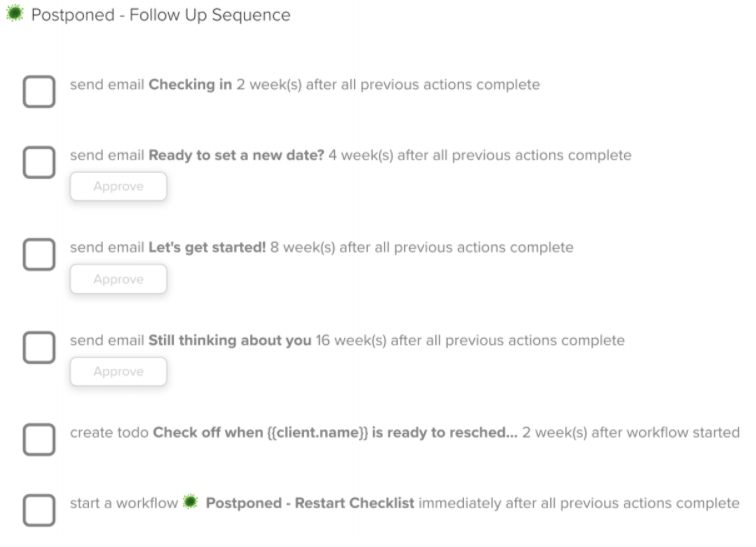Updating Your Projects During COVID-19
Hi Dubsado Family -
Hope you are doing well during this odd time we are all facing. We understand that your clients with in-person projects have most likely reached out to you to hopefully post-pone or to cancel. We hope this guide helps for getting through this time.
Goal
Learn how to handle project cancellations and postponements on a case-by-case basis, especially making manual changes to invoices and workflows.
It helps to be familiar with...
Project titles and dates
Project statuses and tags
Building and sending forms
Invoices and payment schedules
Workflows
Prep Work
1. If you need a sub agreement to amend your contracts, create a template! You might need one version for postponed projects and another for cancelling projects. Consult your attorney.
2. Set up any canned emails you think you'll need for sending out sub agreements or other updates.
3. Create a COVID-19 tag so that you can easily find any affected projects in the future. If you're not concerned about tracking projects specifically affected by this event, you could also just use "Cancelled" and/or "Postponed" tags!
4. Create a special project status if you would like to add postponed projects or projects that need your attention due to this issue to that status.
5. Add an income category to the chart of accounts for "Uncollectible Balance" so that you can keep track of any balances that you are writing off on invoices due to cancellation.
6. Review your cancellation and postponement policies already in place. Will you adhere to these policies, change them due to the circumstances, or make special arrangements on a case-by-case basis? Deciding upfront can help you stress less and be more clear with your clients.
7. Double check all your brands - you may need to handle these steps differently across different businesses.
Cancelling a Booked Job
1. Make the project easily identifiable by adding "Cancelled" to the project title.
2. Add an appropriate project tag.
3. Adjust the invoice.
4. If there is no open balance on the invoice, skip this step.
5. If a refund is needed:
- Issue a refund through the payment processor that the client used to pay.
- Apply a refund to the Dubsado invoice.
6. If there is any remaining open balance on the invoice that will not be paid:
7. Add a line item to the invoice for a negative amount. For example, if there is $500 left on the invoice that will not be paid, enter the price for the line item as -$500.
8. Set the category of this line item to "Uncollectible Balance" and add an item name and description that reflects the reason for the cancellation.
9. If necessary, send a sub agreement with any updated terms.
10. Cancel any appointments that will not be kept from the Appointments tab. A cancellation email will automatically be sent to the client.
11. Archive any workflows to stop automation.
12. Remove or mark complete any remaining tasks on the project.
13. Archive the project.
Postponing a Booked Job
1. Add a tag and update the status if you set one up for postponed projects.
2. Update the project date
3. If you have a NEW date: change the project date to the new date.
4. If you do NOT yet have a new date: remove the project date.
5. Pause all workflows on the project, at your discretion:
6. If you set a new project date, any remaining workflow actions triggered by the project date will update to reflect that.
7. If the project will be postponed for an unknown amount of time, we recommend pausing the workflow.
8. Send out a sub agreement if needed to amend contract terms.
9. Adjust payment schedules to avoid untimely email reminders for payment:
10. If your due dates are working off of the project date, the changes you made to the project date in Step 2 should take care of your payment reminders. If you set a new date, the remaining due dates will adjust accordingly. If you removed the date, due dates will reset to "TBD" until you set a new date.
11. If any due dates are NOT based on the project date (after contract signed, after applied to invoice, fixed dates), delete remaining due dates from the invoice for now and plan to re-add them later when you know more.
12. Cancel or reschedule appointments as needed.
13. Assess your tasks. There may be tasks you want to get done now, or tasks you would prefer to remove.
Workflow Ideas for Following Up
If you'd like, you can create a couple of workflows to help out with following up and re-starting a postponed project!
Follow Up Email Sequence Workflow
Create a workflow that sends an email to your client to periodically check in. You can set these emails to require your approval so that you can assess the situation at the time - Dubsado will send you an email reminder to approve! This is a great way to stay on top of those projects you don't want to fall through the cracks.
At the end of this workflow, we added a todo and a start a workflow action for when the client is ready to move forward. At any time, you can remove any send email actions that haven't been sent and click "Force Now" on the create todo action. Checking off the todo will automatically start the checklist workflow.
Checklist Workflow
This workflow will generate a list of tasks to help you restart a project that has been postponed. If you trigger each action "0 days after all previous actions complete", then each todo will be created after you check off the previous todo. Alternatively, you can trigger all the create todo actions "0 days after workflow started" if you want the entire list generated up front - it's up to you!
Here is a full list of the example todos:
Check project date for {{client.name}}, update if needed. **IF PROJECT NOT MOVING FORWARD, ARCHIVE WORKFLOW AND PROJECT IN DUBSADO.
Check payment schedule for {{client.name}}
Review upcoming emails in the workflow for {{client.name}}, adjust/personalize as needed
Check tasks for {{client.name}}, add "create to do" actions to workflow as needed
Check appointments for {{client.name}}, add "send appointment scheduler" action to workflow as needed.
Unpause main workflow for {{client.name}}
The goal of these todos is to help you assess where you were at with the project when you left off and see if any adjustments are needed before starting up again. You may choose to add actions individually to the workflow on a case-by-case basis, or just send out additional items manually.
Heads up! We do not recommend editing your workflow template and using the Update Project Workflows button in this case. Make all your edits on a project-by-project basis.
At the end of the workflow, we recommend changing the project status appropriately once you have completed the list. You may also wish to add your own todos relevant to your specific needs.
For New Leads
If you are not taking new projects on due to uncertainty with the virus, you can remove your lead capture form from your website. Same goes for schedulers embedded on your site.
If you still want to bring leads in, but aren't ready to go through your normal workflow, you could create a separate workflow that sends out an email letting clients know what to expect, and set an appropriate status and tag.
Double check your public proposals and any attached workflows - if you're not in a position to take orders, you may need to remove your public proposal from your site or change out the workflow
Double check any Zapier connections you've set up, if you feel they might be affected by the disruption.





